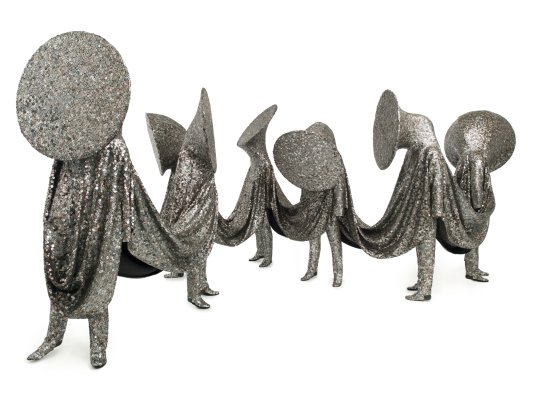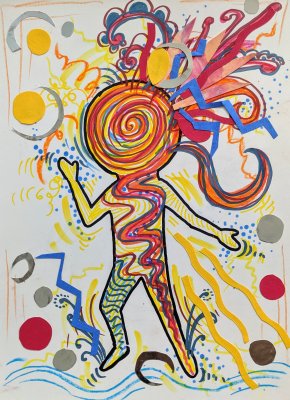Materials
Artmaking
- Drawing paper (or any paper available to you)
- Black marker or pen
- Coloring tools (crayons, markers, colored pencils, etc.)
- Stickers, if available
Guided Play
- Clothing, shoes, jewelry, and other accessories that makes noise when you move while wearing them
- A way to play music (through your computer, phone, radio, etc.)
- A space to dance!
Vocabulary
Texture: physical feel or a touchable sensation on a surface area
Soundsuits: decorative, full body costumes designed to rattle and resonate with the movement of the wearer
Fashion: a popular trend, especially in styles of dress and accessories
Discussion and Video
Begin by using the Teaching Tips and Tools for Discussion. An example of how to bring in information about the artist from something your student observed: If your student observed that it looked like there were people inside the work of art (they may having noticed the feet and legs sticking out from the bottom of the sculpture), you can share that these are "soundsuits," which Nick Cave is well-known for making. Although there isn’t an actual person inside the suit, it could certainly be worn!
Next, watch the following video of “soundsuits” being worn and performed in:
After they watch the video, ask: What did you see? What did you hear? Would you want to wear one of those suits? Why or why not?
For older students: Would you consider these soundsuits fashion, sculpture, or a blend of both?
Let’s compare and contrast: What are the differences that you see between the work in the Albright-Knox's collection and the works in the video (color, material, etc.)? What are some of the similarities (they cover the entire body except the lower legs and feet, it’s a sculpture that can be worn, etc.)?
We suggest showing a picture of the artist before moving on to the project. When students see an image of the artist, especially if the artist is still alive, it helps them to see that art is being made by all types of people, from all over the world.
Artmaking Activity
Overview: This activity encourages young students to use their imaginations inspired by the soundsuits of Nick Cave. For younger students, teachers may wish to send these instructions to parents to follow along. If parents have a printer they can print out the template, or just open it on the screen.
To begin, students should use any drawing/coloring materials available (crayons, colored pencils, markers, etc.) and draw a wild costume. Encourage them to fill in the space around their suit.
Ask: What kinds of lines and shapes do you want to use? Are your lines squiggly, curly, thin, thick, or a zigzag? Remember you can’t see the face, hair color, etc., on Cave’s soundsuits, so feel free to be creative!
Nick Cave used lots of textural materials. If available, students can add stickers to their soundsuit to give it some texture. Now take a look at your creation. Does it have a name? Would you want to wear what you have drawn?

